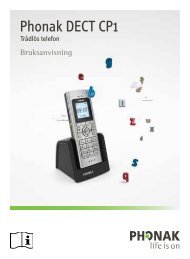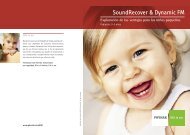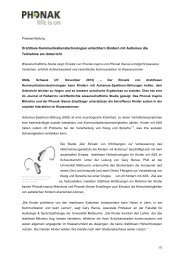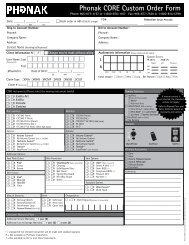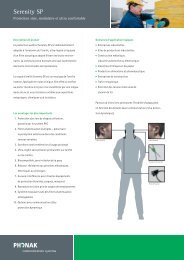User Manual Exélia Art micro / Exélia Art micro Petite - Phonak
User Manual Exélia Art micro / Exélia Art micro Petite - Phonak
User Manual Exélia Art micro / Exélia Art micro Petite - Phonak
You also want an ePaper? Increase the reach of your titles
YUMPU automatically turns print PDFs into web optimized ePapers that Google loves.
<strong>Exélia</strong> <strong>Art</strong> <strong>micro</strong> / <strong>Exélia</strong> <strong>Art</strong> <strong>micro</strong> <strong>Petite</strong><br />
<strong>User</strong> Guide<br />
0459
2<br />
Contents<br />
Welcome 5<br />
Description 6<br />
Short introduction<br />
Inserting the battery 8<br />
Switching ON/OFF 8<br />
Selecting a hearing program 9<br />
Preparation<br />
Replacing the battery 10<br />
Tamper proof battery compartment (optional) 14<br />
Identifying left and right hearing instruments 16<br />
Inserting your hearing system with<br />
<strong>micro</strong> tube into your ear 17<br />
Closed domes 19<br />
Inserting your hearing system with<br />
earmold into your ear 21<br />
Fine tuning based on your personal preferences 24<br />
Operation<br />
Switching ON/OFF 25<br />
Hearing programs 26<br />
Synchronized manual control 28<br />
ZoomControl 28
Telecoil (optional) 29<br />
EasyPhone (optional) 30<br />
Wireless accessories (optional) 33<br />
myPilot 33<br />
iCom 35<br />
iView 37<br />
Remote control (optional) 38<br />
FM communication (optional) 40<br />
Dynamic FM transmitters 41<br />
Multi-frequency FM receivers 42<br />
MyLink 43<br />
EasyFM 44<br />
Maintenance 45<br />
Microphone Protector 45<br />
Micro tube and dome 47<br />
Important points 52<br />
Warning 55<br />
Service and Warranty 56<br />
<strong>Phonak</strong> distributors worldwide 60<br />
3
4<br />
This symbol indicates features, options and<br />
accessories which are available for <strong>Exélia</strong> <strong>Art</strong><br />
<strong>micro</strong> and not for the <strong>Exélia</strong> <strong>Art</strong> <strong>micro</strong> <strong>Petite</strong><br />
version.
Welcome<br />
Your new <strong>Exélia</strong> <strong>Art</strong> hearing system uses the very latest<br />
advances in digital hearing technology. <strong>Exélia</strong> <strong>Art</strong><br />
offers you, automatically, the highest sound quality,<br />
speech understanding and listening comfort in all your<br />
hearing situations. High-tech has turned highly<br />
sophisticated hearing systems into convenient devices<br />
that are easy to use.<br />
Please read this manual carefully to benefit from all the<br />
features of your new hearing system. Ask your hearing<br />
care professional if you have any questions.<br />
<strong>Exélia</strong> <strong>Art</strong> is a quality product developed by the Swiss<br />
company <strong>Phonak</strong>, a world leader in hearing technology,<br />
innovation and reliability. With proper care and usage,<br />
your hearing system will support your hearing and<br />
communication needs for many years.<br />
For further information, please visit the <strong>Phonak</strong> website<br />
www.phonak.com<br />
<strong>Phonak</strong> – life is on<br />
5
6<br />
Description<br />
<br />
<br />
<br />
<br />
<br />
Hearing system with <strong>micro</strong> tube and dome<br />
Microphone inputs with Microphone Protector<br />
Program switch<br />
Battery compartment with nail grip and<br />
ON/OFF switch<br />
Micro tube/sound output<br />
Dome<br />
Retention
Hearing system<br />
with <strong>micro</strong> tube<br />
and SlimTip<br />
– See <br />
<strong>micro</strong> tube<br />
and dome<br />
Individual SlimTip<br />
Removal handle<br />
Hearing system<br />
with earmold<br />
– See <strong>micro</strong> tube<br />
<br />
and dome<br />
Hook /<br />
<br />
<br />
sound output<br />
Individual<br />
earmold<br />
<br />
<br />
<br />
<br />
<br />
<br />
<br />
<br />
<br />
7
8<br />
Short introduction<br />
Inserting the battery<br />
Details see page 10<br />
Switching ON/OFF<br />
Details see page 25<br />
OFF<br />
ON
Selecting a hearing program via Toggle<br />
Details see page 26<br />
9
10<br />
Preparation<br />
Replacing the battery<br />
Use battery size 13 for your <strong>Exélia</strong> <strong>Art</strong> <strong>micro</strong> system.<br />
Use battery size 10 or 312 for your <strong>Exélia</strong> <strong>Art</strong> <strong>micro</strong><br />
<strong>Petite</strong> system (see page 12).<br />
Using the nail grip, open the battery compartment<br />
completely and remove the old battery.<br />
Remove the protective foil from<br />
the new battery. Wait for<br />
two minutes before inserting it.
Insert the new battery with the “+” sign (flat side<br />
of the battery) as shown below. The correct battery<br />
orientation can also be seen on the inside of the<br />
battery compartment. Close the battery compartment.<br />
11
12<br />
Preparation<br />
Your <strong>Exélia</strong> <strong>Art</strong> <strong>micro</strong> <strong>Petite</strong> hearing system can be<br />
operated either with size 10 (standard) or size 312<br />
batteries (optional). Your hearing care professional<br />
may modify the devices accordingly. The 312 battery<br />
lasts longer. The 10 battery creates an even smaller<br />
overall instrument size (refer to picture below).<br />
10 battery<br />
312 battery
Handle the battery compartment with care and<br />
do not use excessive force.<br />
If there is any resistance when closing the<br />
compartment, ensure that the battery is<br />
inserted correctly. The compartment may not<br />
close properly if the battery is upside down,<br />
and the instrument will not work.<br />
When your hearing system is not in use, leave<br />
the battery compartment open to allow any<br />
moisture to evaporate.<br />
Low battery warning<br />
An acoustic signal gives you an early warning that<br />
the battery is approaching exhaustion. You have<br />
approximately 30 minutes to replace the battery after<br />
hearing the signal. The hearing system will repeat<br />
the low battery warning approximately every 30 minutes.<br />
Please note that the battery consumption increases<br />
with regular use of the myPilot command center ,<br />
the iCom communication interface or the remote<br />
controls KeyPilot2 or WatchPilot2.<br />
13
14<br />
Preparation<br />
Tamper proof battery compartment (optional)<br />
The battery is locked inside the battery compartment<br />
for safety reasons. The latch can easily be opened with<br />
a fingernail. Place the fingernail in the groove and pull<br />
the latch away from the hearing instrument and<br />
then push it upwards .<br />
<br />
“click”
The battery can only be inserted when the latch is open<br />
. Move the latch over the inserted battery so that<br />
it lies against it . Lock the battery by pushing towards<br />
the hearing instrument with your finger . Before you<br />
close the battery compartment, check that the latch is<br />
locked in position and the battery can’t be removed.<br />
<br />
Warning: The battery latch must be placed back<br />
over the battery and locked before closing the battery<br />
compartment.<br />
<br />
“click”<br />
<br />
15
16<br />
Preparation<br />
Identifying left and right hearing instruments<br />
It is important to use the correct hearing instrument for<br />
each ear.<br />
Your hearing care professional can mark the hearing<br />
instruments for you. The color code is visible when<br />
the battery compartment is opened. It will identify left<br />
and right hearing instruments as follows:<br />
<strong>Exélia</strong> <strong>Art</strong> <strong>micro</strong><br />
red = right hearing instrument<br />
blue = left hearing instrument<br />
<strong>Exélia</strong> <strong>Art</strong> <strong>micro</strong> <strong>Petite</strong>
Inserting your hearing system with <strong>micro</strong> tube<br />
into your ear<br />
Open domes and SlimTip<br />
<br />
Place the hearing<br />
instrument over the top<br />
of your ear .<br />
<br />
Hold the <strong>micro</strong> tube where it attaches to the dome<br />
or SlimTip and gently push the dome or SlimTip into<br />
your ear canal. The dome or SlimTip should be placed<br />
far enough into the ear so that the <strong>micro</strong> tube lies<br />
flush with your head.<br />
17
18<br />
Preparation<br />
<br />
Place the retention tail (if available) of the <strong>micro</strong> tube<br />
into the bowl part of your ear .<br />
To remove your hearing instrument, grasp the <strong>micro</strong><br />
tube near the dome and pull it out of your ear gently<br />
but firmly.<br />
In very rare cases, the dome can remain in the<br />
ear canal when removing the <strong>micro</strong> tube from<br />
the ear. In the unlikely case that any parts remain<br />
in the ear canal, it is strongly recommended to<br />
see a medical specialist for safe removal.
Closed domes<br />
The closed dome has a different design than other domes<br />
(refer to pictures). The closed dome consists of two<br />
fins overlapping each other. Before inserting the closed<br />
dome into the ear canal, it is important to check the<br />
position of these fins. The larger fin must be positioned<br />
over the smaller fin . If the position is incorrect ,<br />
you can easily adjust it. With one finger, gently bend<br />
the bigger fin forwards and then back again so that<br />
it overlaps the smaller one . Make sure that the slit<br />
of the closed dome is in a horizontal position on<br />
the tube unit . Your closed dome is now ready to<br />
be inserted into the ear.<br />
19
20<br />
Preparation<br />
Correct position <br />
Wrong position <br />
Moving the fins
Inserting your hearing instrument with earmold<br />
into your ear<br />
Using the hand on the same side you wear your hearing<br />
instrument, grasp the earmold between the thumb and<br />
index finger.<br />
Raise your hand to your ear making sure the canal<br />
portion of the earmold faces your ear. Tilt your hand<br />
slightly forward.<br />
21
22<br />
Preparation<br />
Place the canal portion of the earmold inside your ear<br />
canal. If it is difficult to get it into place, stretch your ear<br />
by pulling it gently backwards and upwards with your<br />
other hand. When the canal portion is in place, twist the<br />
earmold backwards so that it fits into the bowl part of<br />
your ear and the helix portion is under the fold.
Now position the hearing<br />
instrument behind the ear.<br />
Be careful not to twist<br />
the tubing.<br />
Check the placement of the<br />
earmold by tracing the<br />
contour of the ear with your<br />
finger.<br />
To remove your hearing<br />
instruments grasp the earmold,<br />
not the tubing, and pull it<br />
out of your ear gently but firmly.<br />
23
24<br />
Preparation<br />
Fine tuning based on your personal preferences<br />
The fitting process has limited capabilities of<br />
reproducing the full spectrum of your personal sound<br />
environments. This limitation is overcome by the<br />
ability of your hearing system to learn from your real<br />
life volume adjustments. When used with a myPilot,<br />
<strong>Exélia</strong> <strong>Art</strong> offers a unique functionality called<br />
“Self Learning”. In every environment, it logs your<br />
personal volume changes within the hearing system.<br />
This means that every time you change the volume of<br />
your hearing system, this correction is taken into<br />
account to apply your preferred volume automatically<br />
when you are in a similar environment next time.<br />
Self Learning cleverly ensures that your volume corrections<br />
in each environment contribute to a fully personalized<br />
volume setting.
Operation<br />
Switching ON/OFF<br />
Switching OFF<br />
Switching ON<br />
Using the nail grip, slightly open<br />
the battery compartment until it<br />
snaps to its OFF position.<br />
Close the battery compartment.<br />
Your hearing system is always<br />
in the default hearing program<br />
and at your preferred volume<br />
when turned ON.<br />
25
26<br />
Operation<br />
Delayed activation<br />
The <strong>Exélia</strong> <strong>Art</strong> hearing system requires several seconds<br />
to start up. Your hearing care professional may have<br />
activated a further delayed activation timer. This function<br />
delays the activation of the hearing system (for 9 or 15<br />
seconds) after the battery door is closed in order to<br />
avoid any disturbance while placing it on your ear. An<br />
acoustic signal confirms when your hearing system is<br />
switched on.<br />
Hearing programs<br />
Automatic mode<br />
<strong>Exélia</strong> <strong>Art</strong> is able to recognize different hearing<br />
environments and to automatically select the most<br />
appropriate hearing program.<br />
Additional program selection<br />
Upon request, your hearing care professional can<br />
program for you additional individual hearing programs<br />
dedicated to specific hearing situations. Additional<br />
programs are accessed via the myPilot command<br />
center , the program switch or other remote<br />
controls such as KeyPilot2 or WatchPilot2.
Program switch<br />
The program switch allows manual toggling between the<br />
“Automatic Mode”, the “Mute Mode” and individual<br />
hearing programs. A short melody confirms the selection<br />
of the “Automatic Mode”.<br />
Option without program switch<br />
The <strong>Exélia</strong> <strong>Art</strong> <strong>micro</strong> hearing system is also available<br />
without the program switch. This could be an option for<br />
users who do not need an extra program switch<br />
together with their myPilot command center or their<br />
remote control.<br />
27
28<br />
Operation<br />
Synchronized manual control<br />
An automatic synchronisation for program selection,<br />
called QuickSync, is integrated in your hearing system.<br />
<strong>User</strong>s wearing two hearing instruments only have to<br />
activate the functionality on one instrument; the other<br />
one will be adjusted automatically.<br />
ZoomControl<br />
This special hearing program allows you to choose from<br />
four directions in which to focus your hearing system<br />
(front, back, left or right). ZoomControl can be accessed<br />
via the myPilot command center and/or the program<br />
switch on your hearing system.
Telecoil (optional)<br />
Your hearing care professional may have activated a<br />
Telecoil in your hearing system. The programs with<br />
Telecoil can be used with hearing system compatible<br />
phones or via inductive loop systems (present in some<br />
school settings, theatres, churches etc.).<br />
Ask your hearing care professional to print out the<br />
complete description of your individual hearing<br />
programs and how to access them with your myPilot<br />
command center , the program switch or a<br />
remote control.<br />
29
30<br />
Operation<br />
EasyPhone (optional)<br />
Your hearing care professional may have activated<br />
EasyPhone in your hearing system. The EasyPhone<br />
function enables your hearing system to automatically<br />
select your telephone program when the telephone<br />
handset is held close to your ear. An acoustic signal<br />
confirms the switch. It automatically returns to<br />
the previous hearing program when the telephone<br />
handset is removed from your ear.<br />
Some telephones produce a magnetic field strong enough<br />
to activate your EasyPhone function. Most types of<br />
telephones require an additional magnet fixed on the<br />
receiver to activate this function.<br />
Fixing the EasyPhone magnet<br />
Clean the telephone handset<br />
thoroughly. Hold the telephone<br />
handset nearly vertically, similar<br />
to making a telephone call. Hold<br />
the magnet near to the “listening<br />
end” of your telephone handset<br />
and release it. The magnet will<br />
automatically flip to the correct<br />
side.
If you hold the telephone receiver<br />
in your right hand when making<br />
telephone calls, position the magnet<br />
in the upper right half of the<br />
receiver.<br />
If you hold the telephone receiver<br />
in your left hand, position the<br />
magnet in the upper left half of<br />
the receiver.<br />
Use the double-sided adhesive<br />
tape to stick the magnet to the<br />
location described above. Do<br />
not cover the sound openings of<br />
your handset.<br />
Instead of holding the phone<br />
against your ear canal, hold the<br />
earpiece of the phone against<br />
the <strong>micro</strong>phone, which is at the<br />
front of your <strong>Exélia</strong> <strong>Art</strong>.<br />
31
32<br />
Operation<br />
Use of EasyPhone<br />
Use the telephone in a normal manner. An acoustic<br />
signal indicates the activation of the EasyPhone<br />
program. At the beginning, you may need to move<br />
the handset slightly to find the optimum position<br />
for a reliable switch and comfortable hearing.<br />
If necessary, move the magnet to another position on<br />
the handset to increase your comfort of use.<br />
Keep magnets out of reach of children and pets.<br />
If a magnet is swallowed, please seek the advice<br />
of a medical practitioner.<br />
The magnet used to strengthen the magnetic field<br />
of your phone may affect some medical devices<br />
or electronic systems. Always keep the magnet (or<br />
the telephone equipped with the magnet) at least<br />
30 cm (12”) away from pacemakers, credit cards<br />
or other magnetically sensitive devices.<br />
High distortion during dialing or phoning may<br />
mean that the phone receiver is stressed by<br />
the magnet. To avoid any damage, please move<br />
the magnet to another place on the telephone<br />
receiver.
Wireless accessories (optional)<br />
myPilot<br />
The myPilot command center is an optional accessory<br />
for your hearing systems. It allows a convenient,<br />
user-friendly and discreet control of all the functions<br />
of your hearing system and additional benefits.<br />
Volume control<br />
Program selection<br />
Automatic mode selection<br />
Access to ZoomControl program<br />
Clock and alarm<br />
myPilot battery status<br />
Read out of hearing instrument volume,<br />
programs and battery status<br />
For detailed information<br />
on the use of your myPilot,<br />
please refer to its user<br />
guide or ask your hearing<br />
care professional.<br />
myPilot:<br />
available in two stylish colors,<br />
high-tech gray or white.<br />
33
34<br />
Wireless accessories (optional)<br />
For optimum results, position your myPilot as shown<br />
in the drawing.<br />
Operating range<br />
max. 50 cm (20”)<br />
Do not use your myPilot in locations where<br />
it is forbidden to use electronic devices.
iCom<br />
iCom is an optional accessory<br />
available for <strong>Exélia</strong> <strong>Art</strong> hearing<br />
systems. With the push of a<br />
single button, iCom connects your<br />
hearing system with the<br />
technology around you.<br />
Bluetooth connections<br />
iCom offers a simple way to connect your mobile<br />
phone via Bluetooth to your hearing system.<br />
iCom is also capable of transmitting a stereo<br />
audio signal from any Bluetooth enabled device<br />
(built-in or via an adapter) such as MP3 players,<br />
laptops, computers or televisions.<br />
Please refer to the iCom user guide for more information<br />
on the numerous iCom applications.<br />
Do not use your iCom in locations where it is<br />
forbidden to use electronic devices.<br />
35
36<br />
Wireless accessories (optional)<br />
FM compatibility<br />
iCom also offers FM accessibility when a <strong>Phonak</strong> FM<br />
receiver is connected, refer to picture below.<br />
EasyAudio and EasyBluetooth<br />
Your hearing system contains two special audio<br />
programs: EasyAudio and EasyBluetooth. These<br />
programs are automatically selected in your hearing<br />
system when an audio or Bluetooth signal is received<br />
from iCom. EasyAudio and EasyBluetooth ensure<br />
that you have the optimum program activated for<br />
streaming. An acoustic signal in your hearing<br />
instruments confirms the switch to either Easy<br />
program.<br />
Do not use your iCom in locations where it is<br />
forbidden to use electronic devices.
iView<br />
iView, the status viewer, is an optional accessory for<br />
parents with small children and also for teachers<br />
or caregivers. Just by the press of a button, iView shows<br />
the status of the hearing instrument's battery, the<br />
current hearing program and volume settings, displayed<br />
on a large screen.<br />
For detailed information on the use of iView,<br />
please refer to its user guide or ask your hearing care<br />
professional.<br />
Do not use your iView in locations where it is<br />
forbidden to use electronic devices.<br />
37
38<br />
Remote control (optional)<br />
<strong>Phonak</strong> offers a comprehensive range of modern remote<br />
controls. Ask your hearing care professional to<br />
demonstrate them to you. Choose the model that is<br />
most convenient for your lifestyle and your taste.<br />
WatchPilot2<br />
Exclusive and modern,<br />
available for women and men,<br />
with sporty rubber band<br />
or elegant metal band.<br />
KeyPilot2<br />
Small, easy and<br />
convenient.
For best results with your KeyPilot2 or WatchPilot2<br />
remote control, refer to the drawing.<br />
For detailed information on the use of your remote<br />
control, please refer to its user guide. Your hearing care<br />
professional can also print an individual description<br />
of your hearing programs for you.<br />
Do not use your remote control in locations<br />
where it is forbidden to use electronic devices.<br />
39
40<br />
FM communication (optional)<br />
Your hearing system is equipped with Direct Audio<br />
Input (DAI). It allows you to fully benefit from the<br />
high-end FM systems from <strong>Phonak</strong>.<br />
When noise, distance or reverberation is a problem,<br />
FM systems greatly improve communication. A wireless<br />
FM communication system consists of a transmitter<br />
and a receiver. The transmitter is placed near, or directly<br />
connected to the sound source (e.g. TV or radio).<br />
It transmits the signal via radio to the FM receivers<br />
attached either to your hearing instruments or to<br />
an iCom.<br />
For more information on the use of your FM system,<br />
please refer to the appropriate FM transmitter or<br />
receiver user guide or ask your hearing care professional.
Dynamic FM transmitters<br />
<strong>Phonak</strong> offers Dynamic FM transmitters for all<br />
customers and needs:<br />
inspiro<br />
The transmitter for teachers<br />
and suitable for use in schools<br />
SmartLink+<br />
For teenagers and adults who want<br />
nothing less than the very best<br />
ZoomLink+<br />
Comfortable transmitter<br />
for everybody<br />
EasyLink+<br />
The transmitter that is easiest<br />
to operate<br />
41
42<br />
FM communication (optional)<br />
Multi-frequency FM receivers (see page 8)<br />
<strong>Phonak</strong> recommends the following FM receiver<br />
with your <strong>Exélia</strong> <strong>Art</strong> hearing system.<br />
MicroLink ML12i : Perfectly integrated into the <strong>Exélia</strong><br />
<strong>Art</strong> <strong>micro</strong> design for daily use. Switching ON/OFF<br />
on the hearing system can easily be done (see page 8).
MyLink<br />
As an alternative to iCom with an FM receiver, MyLink<br />
is a small and appealing FM receiver that is compatible<br />
with hearing systems with a Telecoil.<br />
MyLink picks up the FM signal and relays it to the<br />
hearing instrument.<br />
43
44<br />
FM communication (optional)<br />
EasyFM<br />
The EasyFM function automatically selects your FM<br />
program when an FM receiver is connected to your<br />
hearing system in automatic mode and an FM signal<br />
is detected. An acoustic signal confirms the switch.<br />
The hearing system switches back to the automatic<br />
mode when the FM signal is turned off.<br />
You can always manually override the EasyFM function<br />
with the program switch or a remote control.<br />
<strong>Manual</strong> selection of an FM program<br />
myPilot command center : choose your desired<br />
FM program. The selection is confirmed by an<br />
acoustic signal.<br />
Program switch : toggle until you reach the<br />
desired FM program, identified by the appropriate<br />
acoustic signal.<br />
Remote controls: KeyPilot2 or WatchPilot2 let<br />
you toggle through the desired manual programs<br />
as selected by your hearing care professional.
Maintenance<br />
Microphone Protector<br />
Important: The Microphone Protector is an exclusive<br />
<strong>Phonak</strong> system designed to protect the <strong>Exélia</strong> <strong>Art</strong><br />
high-tech <strong>micro</strong>phones from debris. As a result, they<br />
last much longer, reducing the service costs of your<br />
hearing system. The Microphone Protector can be<br />
replaced if needed. Your hearing system should never<br />
be used without the Microphone Protector.<br />
45
46<br />
Maintenance<br />
Important: Consult your hearing care professional about<br />
changing the Microphone Protector if you experience<br />
any of the following:<br />
The hearing system sounds quieter than usual<br />
There is a reduction in sound quality<br />
Understanding in noise becomes more difficult<br />
It becomes more difficult to determine the direction<br />
of sounds<br />
Your hearing care professional can tell you whether the<br />
Microphone Protector should be exchanged or not.
Micro tube and dome<br />
The following care and maintenance instructions<br />
will help extend the life span and ensure the quality<br />
and comfort of your hearing instrument fit with the<br />
<strong>micro</strong> tube.<br />
The <strong>micro</strong> tube feeds the amplified sound from the<br />
hearing instrument into the ear. It is important that the<br />
<strong>micro</strong> tube, the dome or SlimTip fit correctly into your<br />
ear. If the <strong>micro</strong> tube, the dome or SlimTip irritate your<br />
ear in any way and prevent you from wearing your<br />
hearing instrument, please contact your hearing care<br />
professional. You should never attempt to modify<br />
the shape of the <strong>micro</strong> tube yourself. The <strong>micro</strong> tube,<br />
the dome or SlimTip should be cleaned regularly.<br />
Step 1<br />
Hold the dome and remove the ear wax from the grid<br />
of the dome with a small brush or fabric.<br />
If hearing performance does not improve after step 1<br />
proceed to step 2.<br />
47
48<br />
Maintenance<br />
Step 2<br />
Detach the <strong>micro</strong> tube from the hearing instrument as<br />
follows:<br />
Hold the <strong>micro</strong> tube in one hand and the hearing<br />
instrument in the other hand.<br />
Gently twist the <strong>micro</strong> tube 90° and pull it<br />
straight out, away from the hearing instrument .<br />
90°
Insert the cleaning rod where the <strong>micro</strong> tube attaches<br />
to the hearing instrument and push it all the way<br />
through the <strong>micro</strong> tube and out through the dome or<br />
SlimTip . After cleaning it is important to remove<br />
the cleaning rod.<br />
<br />
49
50<br />
Maintenance<br />
Attach the <strong>micro</strong> tube onto the hearing instrument as<br />
follows:<br />
Hold the <strong>micro</strong> tube in one hand and the hearing<br />
instrument in the other hand.<br />
Push the <strong>micro</strong> tube onto the hearing instrument<br />
until it is snug .
It is not recommended to submerge or rinse the<br />
<strong>micro</strong> tube, the dome or SlimTip in water, as there<br />
is a risk that a water drop may become lodged<br />
in the <strong>micro</strong> tube. As a consequence, sound will be<br />
prevented from going through the <strong>micro</strong> tube.<br />
The <strong>micro</strong> tube and dome should be changed every<br />
three months or sooner if the <strong>micro</strong> tube becomes<br />
stiff or brittle. Only your hearing care professional<br />
should change the dome. This is to prevent the<br />
dome from detaching from the <strong>micro</strong> tube during<br />
insertion into the ear.<br />
51
52<br />
Maintenance<br />
Important points<br />
1) Always use new batteries for your <strong>Exélia</strong> <strong>Art</strong><br />
hearing system. You can return empty batteries<br />
to your hearing care professional.<br />
2) When your hearing system is not in use, leave<br />
the battery compartment open to allow any<br />
moisture to evaporate.<br />
3) If you will not be using your hearing system for<br />
a long period of time, store it in its protective case.<br />
Remove the batteries and leave the battery<br />
compartments open. Make sure your hearing system<br />
is completely dry before closing the case.<br />
4) Protect your hearing system from excessive moisture<br />
and heat. Always remove it before showering,<br />
bathing or swimming. Do not leave the hearing<br />
system near windows or in a car. Avoid strong jolts<br />
and vibration.
5) Daily cleaning and the use of a drying system is<br />
highly recommended. "C&C line" from <strong>Phonak</strong> is a<br />
complete set of cleansing products. Your hearing<br />
care professional will be glad to advise you.<br />
Never use household cleaning products (washing<br />
powder, soap, etc.) to clean your hearing system.<br />
6) Hair spray, face creams and make-up can damage<br />
hearing systems. Remove the hearing system<br />
before applying cosmetics.<br />
7) If you experience any soreness or inflammation<br />
in or behind your ear, contact your hearing care<br />
professional.<br />
8) If your hearing system fails to operate after you<br />
have correctly inserted new batteries, contact your<br />
hearing care professional for advice. Please remember<br />
to bring your accessories (e.g. myPilot, iCom or<br />
remote control) together with your hearing system<br />
for service enquiries.<br />
53
54<br />
Maintenance<br />
The symbol with the crossed out disposal bin<br />
indicates that this hearing system shall not be<br />
treated as household waste. Please hand over<br />
your old or unused hearing system to the<br />
applicable collection point for the recycling of<br />
electrical and electronic equipment or bring it<br />
to your hearing care professional for appropriate<br />
disposal.<br />
By ensuring this product is disposed of correctly,<br />
you will help prevent potential negative effects<br />
on the environment and human health.
Warning<br />
Hearing system batteries are toxic when swallowed!<br />
Keep them out of reach of children and pets. If<br />
batteries are swallowed, please seek the advice of<br />
a medical practitioner!<br />
Only use hearing systems that have been specially<br />
programmed for you by a hearing care professional.<br />
Other instruments may be ineffective and may, in<br />
certain cases, even damage your hearing.<br />
X-ray radiation (e.g. CT scans, MRI scans) may<br />
adversely affect the correct functioning of your<br />
system. We recommend that you remove them<br />
before undergoing X-ray procedures and keep them<br />
outside the room.<br />
Hearing systems in directional <strong>micro</strong>phone mode<br />
reduce mainly background sounds. Warning signals<br />
coming from behind and vehicles’ horns approaching<br />
from behind are partially or completely suppressed.<br />
Changes or modifications made to this<br />
equipment not expressly approved by <strong>Phonak</strong><br />
are not allowed.<br />
55
56<br />
Service and Warranty<br />
<strong>Phonak</strong> offers you a comprehensive global warranty<br />
which becomes effective on the date of purchase. Please<br />
ask your hearing care professional about the details and<br />
duration. This warranty covers any repairs due to defects<br />
in material and/or workmanship. The warranty does not<br />
cover damage from improper handling or care, exposure<br />
to chemicals, immersion in water or undue stress.<br />
Damage caused by third parties or non-authorized service<br />
centers renders the <strong>Phonak</strong> warranty null and void. This<br />
warranty does not include any services performed by<br />
hearing care professionals in their offices. This warranty<br />
applies to the <strong>Phonak</strong> products listed below:<br />
Serial number Serial number<br />
instrument – right: instrument – left:<br />
Date of purchase: Date of purchase:
58<br />
Notices<br />
Notice 1<br />
This instrument is certified under:<br />
FCC ID: KWC-WHSBTE<br />
IC: 2262A-WHS<br />
This device complies with Part 15 of the FCC Rules<br />
and with RSS-210 of Industry Canada. Operation is<br />
subject to the following two conditions:<br />
1) this device may not cause harmful interference, and<br />
2) this device must accept any interference received,<br />
including interference that may cause undesired<br />
operation.<br />
Changes or modifications made to this equipment<br />
not expressly approved by <strong>Phonak</strong> may void the FCC<br />
authorization to operate this equipment.<br />
Notice 2<br />
This Class B digital apparatus complies with Canadian<br />
ICES-003.
Notice 3<br />
This equipment has been tested and found to comply<br />
with the limits for a Class B digital device, pursuant to<br />
Part 15 of the FCC Rules.<br />
These limits are designed to provide reasonable<br />
protection against harmful interference in a residential<br />
installation. This equipment generates, uses, and can<br />
radiate radio frequency energy and, if not installed and<br />
used in accordance with the instructions, may cause<br />
harmful interference to radio communications. However,<br />
there is no guarantee that interference will not occur<br />
in a particular installation.<br />
If this equipment does cause harmful interference to<br />
radio or television reception, which can be determined<br />
by turning the equipment off and on, the user is<br />
encouraged to try to correct the interference by one or<br />
more of the following measures:<br />
Reorient or relocate the receiving antenna<br />
Increase the separation between the equipment<br />
and receiver<br />
Connect the equipment into an outlet on a<br />
circuit different from that to which the receiver is<br />
connected<br />
Consult the dealer or an experienced radio/TV<br />
technician for help<br />
59
60<br />
<strong>Phonak</strong> distributors worldwide<br />
Group companies: (detailed information on<br />
www.phonak.com)<br />
Australia <strong>Phonak</strong> Australasia Pty. Ltd.<br />
Baulkham Hills N.S.W 2153<br />
Austria Hansaton Akustische Geräte GmbH<br />
5020 Salzburg<br />
Belgium Ets Lapperre B.H.A.C. NV<br />
B-1702 Groot-Bijgaarden<br />
<strong>Phonak</strong> Belgium NV, B-1700 Dilbeek<br />
Brazil <strong>Phonak</strong> do Brasil –<br />
Sistemas Audiológicos Ltda.<br />
São Paulo – SP 04363-100<br />
Canada <strong>Phonak</strong> Canada Limited<br />
Mississauga, Ontario L5W OB3<br />
China <strong>Phonak</strong> (Shanghai) Co. Ltd.<br />
Shanghai City 200233<br />
Denmark <strong>Phonak</strong> Danmark A/S<br />
Østre Hougvej 42-44, 5500 Middelfart<br />
France <strong>Phonak</strong> France SA, 69500 Bron<br />
Germany <strong>Phonak</strong> GmbH, 70736 Fellbach-<br />
Oeffingen, EC Representative<br />
India <strong>Phonak</strong> India Pvt. Ltd., 100 034 New Delhi<br />
Italy <strong>Phonak</strong> Italia S.r.l., 20159 Milano<br />
Japan <strong>Phonak</strong> Japan Co., Ltd., Tokyo 101-0044<br />
Jordan <strong>Phonak</strong> Middle East, 11181 Amman<br />
Mexico <strong>Phonak</strong> Mexicana, S.A. de C.V. 03920<br />
México, D.F.MEXICO<br />
Netherlands <strong>Phonak</strong> B.V., 4131PN Vianen<br />
New Zealand <strong>Phonak</strong> New Zealand Ltd., Takapuna<br />
Auckland 9<br />
Norway <strong>Phonak</strong> AS, 0105 Oslo
Poland <strong>Phonak</strong> Polska SP Z.0.0 00-567 Warszawa<br />
Portugal <strong>Phonak</strong> Ibérica S.A., 03008 Alicante, Spain<br />
Russian Federation <strong>Phonak</strong> CIS Ltd., Moscow, 115114<br />
Spain <strong>Phonak</strong> Ibérica S.A., 03008 Alicante<br />
Sweden <strong>Phonak</strong> AB, 117 43 Stockholm<br />
Switzerland <strong>Phonak</strong> AG, <strong>Phonak</strong> Schweiz, 8712 Stäfa<br />
Turkey <strong>Phonak</strong> Turkey A.S., 34357 Istanbul<br />
United Kingdom <strong>Phonak</strong> UK Limited<br />
Warrington, Cheshire WA1 1PP<br />
USA <strong>Phonak</strong> LLC, Warrenville, IL 60555-3927<br />
Independent general A complete list of <strong>Phonak</strong> distributors<br />
distributors: is available at <strong>Phonak</strong>'s Internet site:<br />
www.phonak.com<br />
Please visit us or ask your hearing care<br />
professional for information.<br />
Manufacturer: <strong>Phonak</strong> AG, Laubisrütistrasse 28<br />
CH-8712 Stäfa, Switzerland<br />
61
62<br />
XXXX<br />
Safety notice<br />
Operating<br />
conditions<br />
The CE symbol is a confirmation by <strong>Phonak</strong> AG<br />
that <strong>Exélia</strong> <strong>Art</strong> products and accessories meet<br />
the requirements of directive 93/42/EEC on<br />
medical devices and the R&TTE Directive<br />
1999/5/EC on Radio and Telecommunication<br />
Terminal Equipment.<br />
The numbers after the CE symbol are the<br />
numbers of consulted certified bodies under the<br />
above mentioned directives.<br />
This symbol indicates that <strong>Exélia</strong> <strong>Art</strong> products<br />
comply with requirements for a BF type applied<br />
part according to EN 60601-1. The surface of<br />
the hearing system is specified as applied part<br />
type BF.<br />
This symbol indicates that it is important that<br />
the user refers to associated warnings given in<br />
this user guide.<br />
External devices may only be connected if<br />
they have been tested in accordance with<br />
corresponding IECXXXXX standards. Only use<br />
accessories approved by <strong>Phonak</strong> AG.<br />
The product has been designed for trouble-free<br />
operation without restrictions when used as<br />
intended, unless otherwise stated in this user<br />
guide.
Transportation and<br />
storage conditions<br />
Temperature should not exceed limits of<br />
–20°/60° Celsius at a relative air humidity<br />
of 65% for extended periods during<br />
transportation and storage. Air pressure<br />
between 500 and 1100 hPa is not<br />
detrimental to the instrument.<br />
Australia & New Zealand<br />
Brazil<br />
China<br />
Japan<br />
South Korea<br />
0459<br />
63
www.phonak.com<br />
029-0218-02/V1.00/2009-03/A+W Printed in Switzerland, © <strong>Phonak</strong> AG, all rights reserved







